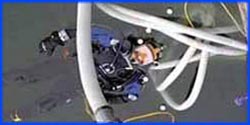


Premier Date: October 13, 2010
In this episode Adam and Jamie teamed up with Sean Casey and Reed Timmer (from the series Storm Chasers) to investigate myths related to tornadoes.
confirmed
Adam and Jamie went to an airfield in Michigan and used the jet engines of a Boeing 747 to generate the needed wind speeds for this test. The test vehicles were positioned directly behind one engine’s exhaust.
In the first test, wind speeds of 160 mph were used. A normal passenger car had its hood torn off and it was pushed back 50 feet. The Storm Chasers’ vehicles suffered no significant damage.
In the second test, the full 250 mph wind was used. The normal car again lost its hood and was thrown back 250 feet. One of the Storm Chasers’ vehicles, Dominator, was turned sideways and slid across the ground but did not lift or tumble. The other vehicle, TIV2, suffered from bent anchor spikes but it did not move at all.
Noting than an occupant in either vehicle would easily have survived, Adam and Jamie declared the myth confirmed.
confirmed
Adam and Jamie wanted to build a device that could protect a person from an F3 tornado with wind speeds up to 180 mph (290 km/h). The shelter had to meet three criteria: protection from blowing away, protection from flying debris, and the ability to tolerate changing wind direction.
After some small scale tests, a low-profile shelter was built using aluminum and ballistic nylon. It featured an anchored, pivoting base and could be collapsed and carried as a backpack. To test the shelter’s debris protection, Jamie fired wooden cylinders at it with a pneumatic cannon. The wood was deflected and caused no significant damage to the shelter or the person within. Tests began with 135 mph winds; the shelter failed due to delamination of the seams. Jamie worked to improve the design and then was able to hold his ground in 180 mph winds.
Previous: Episode 148: Hair of the Dog
Next: Episode 150: Cold Feet